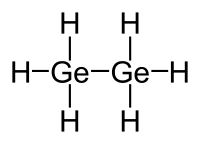Digermane
 | |
| Names | |
|---|---|
| IUPAC name
Digermane | |
| Identifiers | |
| ChemSpider | 20137807 |
| |
| Jmol-3D images | Image |
| |
| Properties | |
| Ge2H6 | |
| Molar mass | 151.328 g/mol |
| Appearance | Colorless gas |
| Density | 1.98 kg/m3 |
| Melting point | -109 °C |
| Boiling point | 31.5 °C |
| Insoluble | |
| Except where noted otherwise, data is given for materials in their standard state (at 25 °C (77 °F), 100 kPa) | |
| Infobox references | |
Digermane is an inorganic compound with the chemical formula Ge2H6. One of the few hydrides of germanium, it is a colourless gas. Its molecular geometry is similar to ethane.[1] Digermane was first synthesized and examined in 1924 by Dennis, Corey, and Moore.[2] Many of the properties of digermane and trigermane were determined in the following decade using electron diffraction studies.[3] Further considerations of the compound involved examinations of various reactions such as pyrolysis and oxidation. Digermane appears to be most important as compound used to test theoretical predictions and explore similarities and differences between group 14 elements. However, there are a few applications utilizing digermane as a germanium precursor, including the formation of organic semiconductors and germanium nanowires.
Synthesis
There are a variety of ways to synthesize germane. One early synthesis of digermane involved the hydrolysis of magnesium germanide using hydrochloric acid and hydrogen gas.[4] It can be produced together with germane by the reduction of germanium dioxide with sodium borohydride, the principal product being germane. Although the major product is germane, a quantifiable amount of digermane is produced in addition to traces of trigermane.[5] It also arises by the hydrolysis of magnesium-germanium alloys.[6]
Reactions
The reactions of digermane exhibit some differences between analogous compounds of the Group 14 elements carbon and silicon. However, there are still some similarities seen, especially in regards to pyrolysis reactions.
The oxidation of digermane takes place at lower temperatures than monogermane. The product of the reaction, germanium oxide, has been shown to act in turn as a catalyst of the reaction. This exemplifies a fundamental difference between germanium and the other Group 14 elements carbon and silicon (carbon dioxide and silicon dioxide do not exhibit the same catalytic properties).[7]
2Ge2H6 + 7O2 → 4GeO2 + 6H2O
In liquid ammonia, digermane is able to undergo disproportionation. Here the solvent, ammonia, acts as a weakly basic catalyst in the disproportionation reaction. Products of the reaction are hydrogen and germane.[8]
2Ge2H6 → 2GeH4 + 2H2
A final important reaction is the pyrolysis of digermane. The pyrolysis mechanism has multiple steps:
Ge2H6 → 2GeH3
GeH3 + Ge2H6 → GeH4 + Ge2H5
Ge2H5 → GeH2 + GeH3
GeH2 → Ge + H2
2GeH2 → GeH4 + Ge
nGeH2 → (GeH2)n
This pyrolysis reaction has been found to be more endothermic than the pyrolysis of disilane, due to the higher strength of the covalent bond between germanium and hydrogen compared to the silicon hydrogen bond. As seen in the last reaction of the mechanism above, pyrolysis of digermane may cause polymerization of the GeH2 group, where GeH3 acts as a chain propagator and molecular hydrogen gas is released. This pyrolysis-polymerization is similar to polymerization mechanisms seen in the pyrolysis of carbon alkenes.[9]
Applications
Digermane has a limited number of practical applications. Generally, digermane is primarily used a precursor to germanium for use in various applications.
For example, digermane can be to create semiconductors in a process known as chemical vapor deposition, which involves the reaction of the volatile digermane gas with the surface of thin wafers composed of germanium or silicon. This technique can be used to create organic semiconductors composed of germanium or a combination of germanium and silicon.[10]
Digermane is also used in the formation of germanium nanowires. Nanowires are small semiconductors that may have a role in nanoscale engineering applications. Digermane can be used as a source of germanium allowing germanium nanowires to grow on gold nucleation sites.[11]
Finally, digermane is a precursor to Ge2H5ECF3 compounds, where E is either a sulfur or a selenium atom. These trifluoromethylthio and trifluoromethylseleno derivatives of digermane possess a markedly higher thermal stability than digermane itself.[12]
References
- ↑ Pauling, Linus; Laubengayer, A. W.; Hoard, J. L. (1938). Journal of the American Chemical Society 60 (7): 1605–1607. doi:10.1021/ja01274a024. Missing or empty
|title=(help) - ↑ Dennis, L.M.; Corey, R. B.; Moore, R.W. (1924). "Germanium. VII. The Hydrides of Germanium". J. Am. Chem. Soc. 46 (3): 657–674. doi:10.1021/ja01668a015.
- ↑ Pauling, L.; Laubengayer, A.W.; Hoard, J.L. (1938). "The electron diffraction study of digermane and trigermane". J. Am. Chem. Soc. 60 (7): 1605–1607. doi:10.1021/ja01274a024.
- ↑ Dennis, L.M.; Corey, R. B.; Moore, R.W. (1924). "Germanium. VII. The Hydrides of Germanium". J. Am. Chem. Soc. 46 (3): 657–674. doi:10.1021/ja01668a015.
- ↑ Jolly, William L.; Drake, John E. (1963). "Hydrides of Germanium, Tin, Arsenic, and Antimony". Inorganic Syntheses 7: 34. doi:10.1002/9780470132388.ch10.
- ↑ Greenwood, Norman N.; Earnshaw, Alan (1997). Chemistry of the Elements (2nd ed.). Butterworth-Heinemann. ISBN 0080379419.
- ↑ Emeleus, H.J.; Gardner, E.R. "The oxidation of monogermane and digermane". J. Chem. Soc. 1938: 1900–1909.
- ↑ Dreyfuss, R.M.; Jolly, W.L. (1968). "Disproportionation of digermane in liquid ammonia". Inorganic Chemistry 7 (12): 2645–2646. doi:10.1021/ic50070a037.
- ↑ Johnson, O.H. (1951). "The Germanes and their Organo Derivatives". Chem. Rev. 48 (2): 259–297. doi:10.1021/cr60150a003.
- ↑ Xie, J.; Chizmeshya, A.V.G.; Tolle, J.; D'Costa, V.R.; Menendez, J.; Kouventakis, J. (2010). "Synthesis, Stability Range, and Fundamental Properties of Si-Ge-Sn Semiconductors Grown Directly on Si(100) and Ge(100) Platforms". Chemistry of Materials 22 (12): 3779–3789. doi:10.1021/cm100915q.
- ↑ Gamalski, A.D.; Tersoff, J.; Sharma, R.; Ducati, C.; Hofmann, S. (2010). "Formation of Metastable Liquid Catalyst during Subeutectic Growth of Germanium Nanowires". Nano Lett. 10 (8): 2972–2976. doi:10.1021/nl101349e.
- ↑ Holmes-Smith, R.D.; Stobart, S.R. (1979). "Trifluoromethylthio and trifluoromethylseleno derivatives of germane and digermane". Inorg. Chem. 18 (3): 538–543. doi:10.1021/ic50193a002.